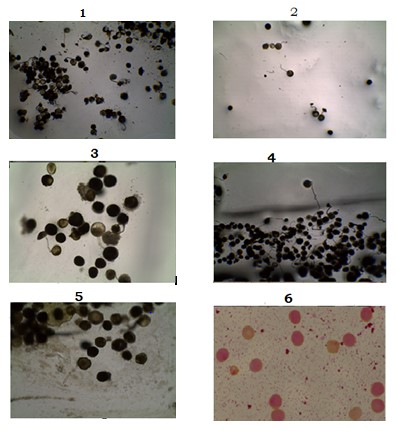Abstract
Pollen viability is a fundamental parameter in the formation of the seed, there are different techniques for its evaluation, of which in vitro germination presents reliable results. Corn pollen has difficulty germinating in culture media due to morphology and physiology. This study aimed to evaluate five In Vitro germination formulations on maize pollen of the Synko hybrid sown under the climatic conditions of Santa Marta-Colombia. The anthesis period occurred 50 days after sowing; the collected pollen grains were placed immediately, on five culture medium already referenced in corn, which are made up of different formulations of agar - agar, sucrose, calcium nitrate and boric acid.The statistical arrangement was a Complete Random Design, eight replications per treatment and two replications over time. The grain count was made on four fields per Petri dish, on 50 grains per field, on a Leica M205 stereo microscope, and on a 40X compound light microscope. The staining technique with 2 % acetocarmin was used as a reference, evaluated on 10 slides per replica, 100 pollen grains per slide. The Culture Medium made up of 0.6 % agar-agar, 17 % sucrose, and 0.03 % calcium nitrate, registered the highest average germination of pollen grains; this is 70.13 %. Pollen staining with acetocarmine exceeded the percentages of viability In VitroReferences
Alcaraz, M. L. 2009. Biología reproductiva del aguacate (Persea americana Mill). Implicaciones para la optimización del cuajado. Tesis de doctorado. Universidad de Málaga, Málaga, España.
Almeida, C., do Amaral, A. L., Barbosa Neto, J. F. and De Melo Sereno, M. J. C. 2011. Conservação e germinação in vitro de pólen de milho (Zea mays subsp. mays). Revista Brasileira de Botanica 34(4), 493–497. Doi: https://doi.org/10.1590/s0100-8404201100040000.
Araméndiz Tatis, H., Cardona Ayala, C. y Jarma Orozco, A. 2013. Eficiencia de dos métodos para evaluar la viabilidad del polen de berenjena (Solanum melongena L. cv. Lila criolla). Revista U.D.C.A Actualidad & Divulgación Científica 16(2): 351–358. Doi: https://doi.org/10.31910/rudca.v16.n2.2013.907.
Bohórquez, W., Gómez, J. y Flórez, V. 2013. Nutritional factors and modification in the content of anthocyanins associated with the blackening of rose petals (Rosa sp.). Revista U.D.C.A Actualidad & Divulgación Científica, 16(1): 103–112. https://doi.org/Doi:10.31910/rudca.v16.n1.2013.864.
Cerovic, R., Pajic, Z., Filipovic, M., Fotiric-Akšic, M., Radicevic, S., Nikolic, D. y Dordevic, M. 2014. Pollen germination and pollen tube growth in ZP maize lines. Genetika 46(3): 935–948. https://doi.org/10.2298/GENSR1403935C.
Corazza Kaefer, K. A., Chiapetti, R., Fogaca, L., Luis Muller, A., Borghetti Calixto, G. y Dall´Olglio, E. I. 2016. Viability of maize pollen grains in vitro collected at different times of the day. African Journal of Agricultural Research 11(12): 1040–1047. Doi: https://doi.org/10.5897/ajar2015.10181.
Davide, L. M. C., Pereira, R. C., Abreu, G. B., Souza, J. C. y Pinho, É. V. R. V. (2009). Viabilidade de Pólen de Milho em Diferentes Períodos de Armazenamento em Baixa Temperatura. Revista Brasileira de Milho e Sorgo 8(2): 199–206. https://doi.org/10.18512/1980-6477/rbms.v8n2p199-206
Federación Nacional de Cultivadores de Cereales. 2010. El cultivo del maíz, historia e importancia. Url: http://hdl.handle.net/20.500.12324/1004 . Consultado: 10 de agosto de 2020.
Fenalce. 2019. Estadística. URL: https://www.fenalce.org/alfa/pg.php?pa=60. Consultado: 10 de agosto de 2020.
González, M., A. Estévez, J. Castillo, J. Salomón, O. Moré y M. Hernández. 2002. La Calidad del polen: requisito indispensable del mejoramiento tradicional de la papa en Cuba. Revista Latinoamericana de la Papa 13(1): 75-94.
Hui Xu, X., Chen, H., Lin Sang, Y., Wang, F., Ping Ma, J., Gao, X.-Q. y Sheng Zhang, X. 2012. Identification of genes specifically or preferentially expressed in maize silk reveals similarity and diversity in transcript abundance of different dry stigmas. BMC Genomics 13(294): 2–17. Doi: https://doi.org/https://doi.org/10.1186/1471-2164-13-294.
Jankovic, D., Jankovic, S., Paunovic, S., Cirkovic, B. y Zaran, N. 2014. Effect of different concentrations of agar, sucrose, boric acid and calcium chloride on pollen germination in english walnut cultivar ‘geisenheim 251.’ International Journal of Biosciences (IJB) 1: 217–223. https://doi.org/10.12692/ijb/4.7.217-223.
MacRobert, J. F., Setimela, P., Gethi, J. y Worku Regasa, M. 2015. Manual de producción de semilla de maíz híbrido. CIMMYT. México, D.F.
Martínez, F.E., Sarmiento, J., Fischer, G. y Jiménez, F. 2009. Síntomas de deficiencia de macronutrientes y boro en plantas de uchuva (Physalis peruviana L.). Agronomía Colombiana 27(2): 169–178.
Pardey Rodríguez, C. 2015. Seed production and crosses among maize (Zea mays L.) accessions of the Magdalena department of Colombia. Acta Agronomica 64(1): 82–91. Doi: https://doi.org/10.15446/acag.v64n1.44551.
Pfahler, P.L. 1967. In vitro germination and pollen tube growth maize (Zea mays L.) pollen: Calcium and boro effects. Canadian Journal of Botany 45(6), 839–845. Doi: https://doi.org/10.1139/b67-087.
Pfahler, P.L. 1981. In vitro germination characteristics of maize pollen to detect biological activity of environmental pollutants. Environmental Health Perspectives 37:125–132. Doi: https://doi.org/10.1289/ehp.8137125.
Rejón García, J., Suárez Rizzo, C., Alché Ramírez, J., Castro López, A. y Rodríguez-García, M. 2010. Evaluación de diferentes métodos para estimar la calidad del polen en distintos cultivares de olivo (Olea europaea L.). Polen 20: 60–72. Doi: https://doi.org/10.14201/pol.v20i0.8921.
Schreiber, D. N. y Dresselhaus, T. 2003. In vitro pollen germination and transient transformation of Zea mays and other plant species. Plant Molecular Biology, 21(3): 31–41. Doi: https://doi.org/10.1007/BF02772809.
Sorkheh, K., Shiran, B., Rouhi, V., Khodambashi, M., Wolukau, J. N. y Ercisli, S. 2011. Response of in vitro pollen germination and pollen tube growth of almond (Prunus dulcis Mill.) to temperature, polyamines and polyamine synthesis inhibitor. Biochemical Systematics and Ecology 39(4–6): 749–757. Doi: https://doi.org/10.1016/j.bse.2011.06.015 .
Taylor, L.P. y Hepler, P. K. 1997. Pollen germination and tube growth. Annual Review of Plant Physiology and Plant Molecular Biology 48(1): 461–491. https://doi.org/10.1146/annurev.arplant.48.1.461.
Vieira de França, L., Nascimiento, W. M., Carmona, R. and Alves de Freitas, R. 2009. Viability of eggplant pollen. Cropp Breeding and Applied Biotechnology 9(4): 320–327. Doi: https://doi.org/10.12702/1984-7033.v09n04a06.
Youmbi, E., The, C. y Tedjacno, A. 2005. Conservation of the germination capacity of pollen grains in three varieties of maize (Zea mays L.). Grana, 44(3): 152–159. Doi: https://doi.org/10.1080/00173130500233271.


